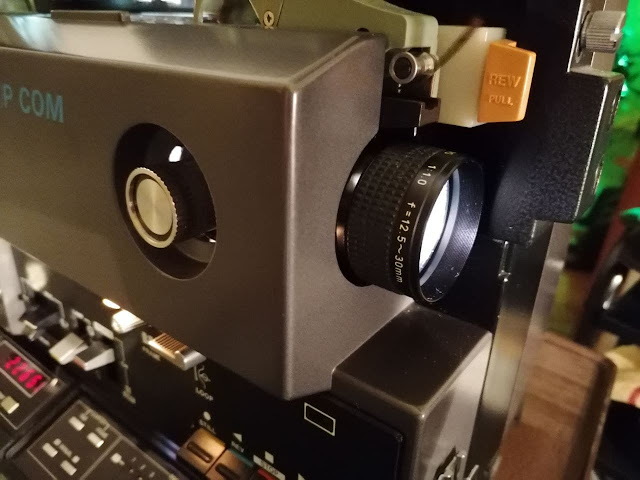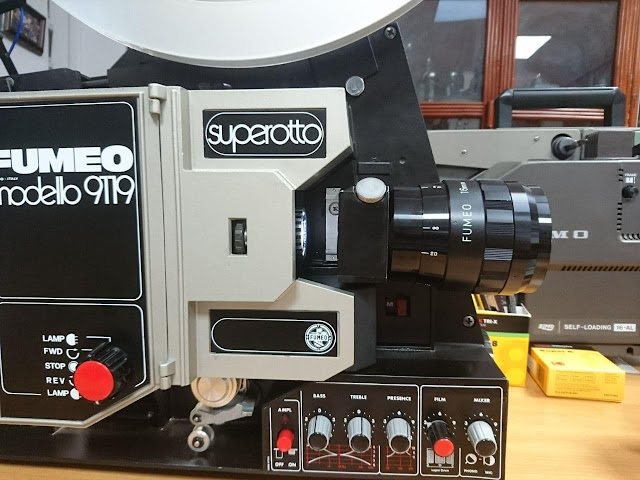In this installment nine of a ten parts article originally published, in extended version by SilverGrain Classics magazine, I write about projectors in the premium class category for the keen ciné enthusiast, as the Fujicascope SH30, Fujicascope SD25, the Bauer Studio range of projectors, the Elmo GS1200, the Beaulieu Studio, the Fumeo 9119 and the Braun Visacustic 2000.
 |
| Fujicascope SD25 Stereo Quartz |
More complex electronically, and with stereo sound, is the Fujicascope SD25, with the same 1.0 lens and 360 meters reels capacity too, but a very useful speed control by quartz, microcomputer, and large digital frame reader. I use the Fujicascope SD25 to build the sound recordings in my movies.
 |
| Fujicascope SH30 |
After the collapse of the Super-8 market, this model was sold at a fraction of its cost, in some markets, as the Yelco 3600 (but with an inferior lens than the original Fujinon 1.0). Also interesting is its younger brother the Fujicascope SD20, with no microprocessor, but retaining the lens and quartz speed control. Quartz is essential when it comes to synchronizing with external devices such as a Blu Ray. In the Fujicascope SD25, being the filmmaker able to see the speed on the LED display, is possible to vary it at will when desired from 16 to 26 f.p.s.
This 3 Fujicascope projectors use the 150 W lamp with good light output, because the fast pull-down of the claw. The excellent electronics giving good sound quality with plenty of outlut power.
The LED digital frame-counter is superb in the SD25, as also the microprocessor system for pre-programming. One strong point of this projectors are the magnetic head, of sendust type, able to last a lot of time! In facts, machines like this were used by Perry´s Movies, in London, to record the sound of commercial prints sold by this company. Further, this 3 Fujicascope sisters can play optical tracks, too.
A very clever design feature, on the Fujicascope SD25 Stereo Quartz (and SD20), for the independent filmmaker, is that all the sound inputs, which allow recording of complex tracks, are located on the front of the projector, and not on the back or the side.
 |
| Braun Visacustic 2000 with original Iscomorphot anamorphic |
BRAUN VISACUSTIC 2000 DIGITAL. More than 40 years after its commercialization, the Braun Visacustic still attracts attention for its exterior design (which seduced Steve Jobs himself. He ordered two units of the 2000 Digital in Lee's Cameras, in 1983, which were personally delivered to him in his house in Belgravia by Martin Lee himself. However, the best of Visacustic is inside:
1) Rear sprung pressure plate (in the lamp side), as in the Beaulieu (which allows project film with different thickness without the need to correct the focus) --more about this feature in installment 6 of this series--
2) Speeds of 16 2/3 and 25 f.p.s., in addition to the normal ones, as well as fine adjustment;3) easy unthreading of a parcially projected film;
5) rounded edge projection frame;
6) swing open type lens holder; and
7) easy external electronic control, to enslave the machine with a Blu Ray reader or a quartz device.
The Halogen Elmos GS1200 use the very special and hard to find powerfull 24V 200W lamp code ESC (only produced in batchs). However, due to their slow pull down, with large blades in the shutter, Elmo GS1200 machines don't extract as much performance of the lamp as they could.
The lens holder is of the swing open type: although without micrometrical focussing and with conventional pressure plate, is very easy to get focus even with th 1.0 lens. Afer the gate, the Elmo GS1200 has a tendece to be unkind with cement splices, in the lower loop and entry to sound section but this is not a trouble for me because I use always Fujifilm tape splices.
The comprehensive sound facilities, and the excellent arrangement of the two traks operation, in stereo, are a must for the filmmaker, with a logical and straighforward arrangement of the amplifier controls for the two channels. Magnetic head, as in the Fujicascope SD25 (and Goko editors) are "sendust", for very long life. Of course, the Elmo GS1200 range has optical sound as standard (even, in Japan, was sold a version with only optical track reading!).
Except for the first version of the GS1200, all the others support perfect sync with quartz devices currently built in Italy by Luigi Petrin and Renzo dal Bo.
Elmo GS1200 are such an extraordinary projectors that one falls in love with them immediately. However, like beautiful lovers, apart from providing pleasure, it also generates a headaches; one problem with the Elmo GS1200 is that when they don't scratch the film in a place or other, then, they have an electronic or mechanical trouble: for this reason, the Elmo GS1200 are projectors that users like me love and hate at the same time!
Bauer T610. This is the top model of the Studio series of the German brand Bauer (models T502, T520, T525, T600 and T610), with stereo sound, a sophisticated electronic programming system and the Schneider f 1.1 11-30 mm as standard. The Studio class, very well made, are the quietest projectors ever manufacturated.
Its two drawbacks are the difficulty of unthreading the film in the middle of the projection and the plastic pressure gate. Neither, I don´t like the auto-thread mechanism, with automatically down the upper loop former, which is switched on every one that you try to stop the projection. But the pull-down claw mechanism is very well made and very kind with film.
Fumeo 9119. This is a 16 mm projector adapted in factory to project Super-8. The Fumeo 9119 was designed mainly as a projection-only machine (although it was sold as 9120 with recording option). This projector, very heavy, transmit a solid engineering and feeling of quality. Picture on screen is so stable and so sharp thant the film grain can be clearly seen on screen, if the projector is with the optional Isco Cineluz f 1.1 11-30 mm lens. The micrometrical focusing of later version is even better than the one of the Beaulieu, as the lens is placed in a lens holder and not fixed with a ring, so, the focus is held throught all the film.
The sound quality is excellent and with a range of controls of frequency charasteristic much more comprehensive than are normally found in Super-8 projectors: there are three separate tone controls, provindig (each independently of others): 1) a bass rise or fall (giving un to more/minus 10dB at 10Hz. 2) A treble rise or fall (ut to more/minus 8db at 10 Kz). 3) A sharp rise in band of middle frequencies centred around 2Kz. Sound is very stable too, thanks to a fly wheel of more than 1 kg. of weight! Projector can play also optical tracks. Standard 9119 was available with stereo magnetic heads as option.
Unlike the majority of lightweight 8 mm projectors, this Fumeo is of all-metal construction with minimal use of plastics. The main body, the back cover and the lampouse are all light-alloy die-castings, aa very strong and rigid assembly.
Experienced projectionists will be delighted to see this machine does not have automatic threading. It is assumed that the projector will be hadled ontly by a capable operator: threading and unthreading is manual. It is a machine designed for constant heavy use with regular mantenance (for example, as described in manual, oiling the felt pad on the claw cam after each 40 hours, and other adjustaments).
The claw pull-down is not very fast, so, the blade sectors are of 60 degrees but the machine is with 2 blades instead 3 blades are usual in Super-8: so, a lot of light reach the screen from the 200W ESC (the very same that Elmo Gs1200), despite despite the fact that the lamp is at a further distance than the regulation.
The drive motor is a large mains-voltage induction motor runing at constant speed: so, no brushes to clean in this kind of industrial motor. Projector has also provision for playing optical sound tracks.
With regular lubrication, a Fumeo 9119 projector should out last our life. The provision for really large reels of film, up to 800 meters. A very stron point is than spares for Fumeo 9119 are still available via Marco Sonetti in marks22son@gmail.com: Marco was a personal friend of Angelo Bianchi, the owner of Fumeo, and bought all the inventary of the beloved Italian factory. Stereo heads for Fumeo projectors are still made today!
What is my recommendation? If budget is a consideration and stereophony is not necessary, and you are looking for a reliable and easy to maintain projector, my recommendation is the Fujicascope SH30 (if you are looking for quartz precision as well, then the Fujicascope SD25 -or its Yelco 3600 clone, which, however, comes with a mediocre lens).
If you value good design, in every way, and you have little space at home, then you should to choose the Steve Jobs's projector: the Braun Visacustic 2000. Anyone looking for a quiet projector has any of the Bauer Studio range (Braun and Bauer are both for 240 meters reels only)
If in addition to being a filmmaker, you are a film-collector of feature films, then the Beulieu Studio. If you are only going to project movies, without recording sound, and you are looking for a projector that can last for eternity... and beyond, then, there is no other option than the Fumeo 9119.
Elmo GS1200 is a magic projector but I do not recommend for isolated filmmakers because, for one reason or another, they are a source of problems: from scratches in the movies to failures in electronics or mechanics (I know, because I own the Elmo GS1200 IV, the PCom and the Xenon). All the faults in the Elmo GS1200 can be solved, but not everyone has access to a competent technician near home, like the Italian Luigi Petrin.
In this series of ten articles, a digest of the one published in the international magazine SilverGrain Classics, are described the most interesting projectors to buy, depending on the use they will be put to.
Which is the best zoom to buy? Article about high quality zooms in European size.


























Very interesting, but permalloy sound heads are not the most durable: the hardest and best performing heads are/were made of sendust alloy: these were installed in several Elmo projectors (including the GS 1200), maybe some Yelco's (not sure) and on the Goko RM 8008. You can easily tell whether a head is made of sendust because it bears the symbol "SA" on one of its sides (visible when removed from the head moount).
ResponderEliminarYou are correct. I have tested specificacions and Fujicascope SD25 projector has "sendust " magnetic head. I correct the text now.
EliminarEstimado Ignacio, que placer leer esta excelente colección de artículos sobre los proyectores de super 8, me quito el sombrero ante tu conocimiento y tu hermosa colección de "juguetes". ¿Me gustaría saber si aun hoy es posible conseguir un proyector FUMEO 9119 y cuanto puede costar. ¿Cuanto pesa un FUMEO 9119? Saludos desde Colombia.
ResponderEliminar